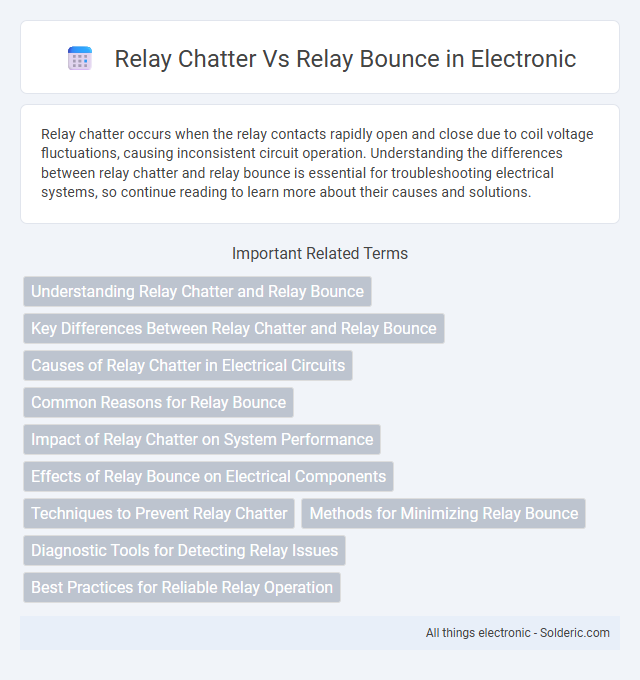Relay chatter occurs when the relay contacts rapidly open and close due to coil voltage fluctuations, causing inconsistent circuit operation. Understanding the differences between relay chatter and relay bounce is essential for troubleshooting electrical systems, so continue reading to learn more about their causes and solutions.
Comparison Table
| Feature | Relay Chatter | Relay Bounce |
|---|---|---|
| Definition | Excessive rapid switching (vibrations) of a relay contact | Relay contact opens and closes unintentionally due to a mechanical or signal fault |
| Cause | Contact vibration caused by coil energizing or mechanical design | Physical bouncing of contacts during closure or opening |
| Impact | Multiple unwanted contact transitions causing signal noise or errors | Transient multiple contacts causing false triggering or noise |
| Duration | Short duration, milliseconds | Very brief, microseconds to milliseconds |
| Mitigation | Dead time or debounce circuitry, use of snubbers | Debounce circuits, software filters, hardware RC networks |
| Common Use Case | Industrial relay controls, signal switching | Switch debouncing in digital inputs |
Understanding Relay Chatter and Relay Bounce
Relay chatter occurs when a relay rapidly opens and closes due to fluctuating input signals or unstable voltage, potentially causing equipment malfunction or damage. Relay bounce refers to the mechanical contacts of the relay momentarily making and breaking contact several times during switching, leading to signal noise or intermittent connections. Correct diagnosis and mitigation of both phenomena are crucial for ensuring reliable relay operation in electrical circuits.
Key Differences Between Relay Chatter and Relay Bounce
Relay chatter refers to the rapid, repeated opening and closing of a relay due to mechanical or electrical instability, often caused by voltage fluctuations or signal noise. Relay bounce occurs when the relay contacts physically bounce upon closing, creating multiple brief interruptions before settling, which can lead to contact wear and signal distortion. Understanding these distinctions helps you diagnose relay behavior issues accurately and optimize circuit performance.
Causes of Relay Chatter in Electrical Circuits
Relay chatter in electrical circuits is primarily caused by fluctuations in supply voltage, mechanical wear of relay contacts, or rapid changes in load current leading to unstable contact activation. Inductive loads without proper suppression can induce voltage spikes that cause relay contacts to open and close rapidly. Insufficient coil voltage or vibrations within the relay mechanism also contribute to intermittent contact operation, resulting in relay bounce.
Common Reasons for Relay Bounce
Relay bounce often occurs due to invalid recipient addresses, causing the mail server to reject messages before delivery. Relay chatter, in contrast, involves the exchange of SMTP commands and responses during a legitimate email relay session. Understanding common reasons for relay bounce can help you troubleshoot issues like misconfigured mail servers, blacklisted IP addresses, or excessive sending limits.
Impact of Relay Chatter on System Performance
Relay chatter causes rapid, repeated switching of contacts, leading to increased electrical noise and wear on relay components, which significantly degrades system performance. This excessive mechanical action can result in signal distortion, reduced relay lifespan, and increased failure rates, causing downtime and maintenance costs to rise. Mitigating relay chatter through proper contact design and debounce circuits improves overall reliability and efficiency in automated systems.
Effects of Relay Bounce on Electrical Components
Relay bounce causes multiple rapid on-off cycles when the relay contacts close, leading to electrical noise and potential voltage spikes that can damage sensitive components. This phenomenon increases contact wear, reduces relay lifespan, and may induce erroneous signals in digital circuits. Proper debounce circuitry or solid-state relays are essential to mitigate these adverse effects and protect electronic devices.
Techniques to Prevent Relay Chatter
Relay chatter can be minimized by implementing proper coil resistance and ensuring adequate voltage supply to prevent unintended oscillations. Using snubber circuits or adding a diode across the relay coil helps absorb voltage spikes and reduces noise that triggers chatter. Additionally, selecting relays with appropriate contact ratings and incorporating hysteresis in the control circuit enhances stability and prevents rapid on-off cycling.
Methods for Minimizing Relay Bounce
Minimizing relay bounce involves using methods such as incorporating flyback diodes to suppress voltage spikes and adding snubber circuits to absorb transient energy. You can also improve relay contact performance by selecting gold-plated contacts or using solid-state relays that eliminate mechanical bounce. Proper maintenance and ensuring the relay operates within its specified voltage and current ratings further reduce the chances of relay chatter and bounce.
Diagnostic Tools for Detecting Relay Issues
Diagnostic tools such as oscilloscopes and spectrum analyzers effectively identify relay chatter by monitoring rapid contact fluctuations and irregular signal patterns. Contact bounce detection utilizes high-speed cameras or contact bounce analyzers to capture minute mechanical vibrations during relay actuation. Precision time-domain reflectometry (TDR) also assists in distinguishing between chatter and bounce by analyzing the temporal characteristics of relay contact transitions.
Best Practices for Reliable Relay Operation
To ensure reliable relay operation, differentiate clearly between relay chatter and relay bounce by implementing proper contact material selection and adequate coil drive voltage to minimize unintended repetitive switching. Use suitable debounce circuits or software filters that help stabilize relay signals, preventing false triggering caused by mechanical vibrations or contact bounce. Your control system should monitor relay status in real time and incorporate diagnostic feedback to detect anomalies promptly and maintain consistent performance.
Relay chatter vs relay bounce Infographic

 solderic.com
solderic.com